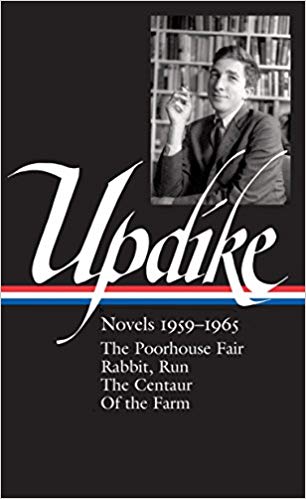Library of America published John Updike: Novels 1959-1965 last November in what amounted to a quiet reissue of the author’s first four novels: The Poorhouse Fair; Rabbit, Run; The Centaur; and Of the Farm. What few reviews that emerged have been almost as ambivalent as those from when Updike first began publishing. Only the “charge” is different. Then it was “He writes like an angel but has nothing to say”; now it’s “Misogynist!”
In his PopMatters review, “Approach ‘John Updike: Novels 1959-1965’ with Indulgence, Patience, and Caution,” Christopher John Stephens acknowledges that Updike was “a formalist, a structuralist, a fantabulist, a writer as steeped in Nathaniel Hawthorne as he was in the pleasures of golfing and the baseball majesty of Ted Williams.” Then the ambivalence starts to seep in: “He wrote some of the most stilted and painfully clumsy bad sex in his ’60s novels and some of the more stunning evocations of longing and regret ever seen in the mid-20th century American white male.” The Poorhouse Fair, he writes, is an “impressive debut. It’s also a hard novel to enter or even like,” while he calls The Centaur “another novel burdened by the yoke of significance”—that “Updike knows his Greek myths, and reading this carefully balanced story is less enjoyable than admirable.”
Later in his review Stephens assesses Updike’s prose style: “Nothing is inherently wrong with these passages. They’re just too precise, too tightly wound.” And regarding Rabbit’s behavior in the first book of the tetralogy, he says, “Updike can’t have it both ways. He can’t be condemning a heartless misogynist while primarily entertaining us by making Rabbit the ping pong ball bouncing between his ‘virgin’ wife mother of his child (Janice) and ex-prostitute girlfriend (Ruth).”

Stephens concludes, “Overall, the reader should approach this volume with equal parts indulgence, patience, and caution. The first should be applied to Updike’s youthful flowery prose and apparent need to impress with each line. The second should be applied to Updike’s tendency to painfully stretch out descriptions in clinical ways. As for the third application, caution, that applies to the carefree racism and horribly misogynistic undertone to the sex scenes and ongoing gender war. Caution can be easily applied, but forgiveness might take more time from even the most patient reader.” Yet he gives the book a 7 on a 10-point scale.
In an assessment written for National Review, “John Updike saw the World as It Was,” Peter Tonguette considers those same four early novels and concludes, “As this collection of his early novels emphatically establishes, Updike was that rare writer whose strength was not in allowing his imagination to wander hither and yon, but in keeping his eyes fixed on what was right in front of him.”
Although Tonguette praises Updike’s “level-headed precision” and calls Rabbit, Run a “dazzling opening book of what evolved into a much-honored tetralogy,” he does write that “stunts mar more than one early Updike work. The Poorhouse Fair–a well-crafted novel that revolves around the denizens of a poorhouse–unaccountably takes place not in or around the year it was written but decades down the line. . . . More unsatisfying still is The Centaur,” with its contemporary story of a father and son “augmented by references to Greek mythology, notably the half-human, half-horse title creature, written in a windy, pretentious style.” Not surprisingly, he calls Of the Farm “the most satisfying offering included here” because of its “careful account of sights and sounds and smells” and concludes, “In the years to come, the Library of America plans to release the balance of Updike’s novels. The best of them are more akin to the earthbound Of the Farm than to The Poorhouse Fair or The Centaur, with their strained, fantastical conceits.
